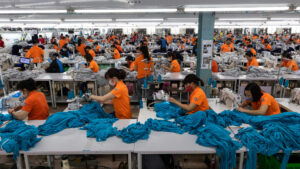The Impact of Tariffs on Your Wallet: What Extreme Investor Network Wants You to Know
As consumers, we’re often at the mercy of global economic policies that impact our daily lives. One such policy is the imposition of tariffs by the U.S. government, which can have a significant effect on the prices we pay for various goods. The recent moves by the Trump administration to slap steep tariffs on imports from dozens of countries is a hot topic, and here at Extreme Investor Network, we believe it’s critical for you to understand how these changes might affect your personal finance strategy.
What Are Tariffs and How Do They Impact Us?
Tariffs are essentially taxes imposed on imported goods. While they are often touted as a method to protect domestic industries, the reality is that they can lead to higher prices for consumers. According to an analysis by Yale University’s Budget Lab, households might experience a devastating loss of $3,800 in purchasing power annually due to these tariffs and retaliatory actions from other countries. This kind of financial pressure can disproportionately affect lower-income families, who may feel the weight of rising costs more acutely.
Clothing Prices Are Set to Rise
If you’ve been eyeing that fashionable coat or pair of shoes, brace yourself. The garment industry is particularly susceptible to tariff-related price hikes. According to the Yale analysis, prices for clothing, shoes, and accessories could increase by anywhere from 10% to 20%. With most apparel sold in the U.S. manufactured overseas, the repercussions of these tariffs will be felt by families across the economic spectrum.
Denise Green, an associate professor at Cornell University, points out that smaller countries known for specialized garment manufacturing will be hit especially hard. While the trend over the past few decades has been a move towards overseas manufacturing, it appears that the U.S. will not see a surge in domestic garment production as a result of these tariffs. This means consumers will have to adjust to paying higher prices for imported clothing—and likely won’t enjoy a return to “Made in America” options anytime soon.
Automobiles: An Increasing Financial Burden
Cars are another major area of concern. You may already be feeling the pinch at the dealership, as the cost of vehicles could swell by over 8% due to the new tariffs. If automakers pass these expenses onto consumers, the price of new vehicles could skyrocket by as much as $10,000. For many Americans—especially those who rely on cars to commute to work, school, and other essential activities—this could mean a significant shift in budget priorities.
The Inflated Cost of Goods
It’s not just clothing and cars; tariffs on everything from steel to electronics trickle down and impact a wide array of consumer products. This includes household staples like appliances. A recent study indicated that tariffs from President Trump’s first term led to a price increase of around 12% on washing machines and dryers.
With the current tariff policies affecting over $2.5 trillion in U.S. imports, the ripple effect could raise the consumer price index by as much as 4.5% by late 2025—significantly above the Federal Reserve’s long-term inflation target.
Take Control of Your Finances in a Tariff-Heavy Environment
So what can you do to mitigate the impact of these economic shifts on your household budget? Here are some strategies:
-
Budget Wisely: Review your household spending and adjust your budget to account for the expected price increases. Consider cutting back on discretionary spending and optimizing necessary expenses.
-
Shop Smart: Keep an eye on price trends in the products you need. Sometimes a little research can help you find the best deals before the prices rise.
-
Explore Alternatives: Consider purchasing secondhand items, which often escape the realm of tariffs. This can be an affordable way to upgrade your wardrobe or household items without the hefty price tag.
-
Seek Local Options: While tariffs might make imported goods pricier, look for local alternatives. Supporting local businesses not only helps keep your costs down but also boosts your community’s economy.
- Stay Informed: Keep yourself updated on changes in tariffs and prices. Understanding the factors behind price changes will help you make more informed purchasing decisions.
At Extreme Investor Network, we are committed to providing you with insights that help bolster your financial wellbeing. Stay connected with us for the latest analyses, updates, and strategies to navigate the ever-evolving landscape of personal finance. Let’s take control of our financial destiny, one informed decision at a time!
By understanding the broader implications of tariffs and their effects, you can make better financial choices that empower you and your family in an uncertain economic climate. Remember, knowledge is power—especially when it comes to your wallet!

